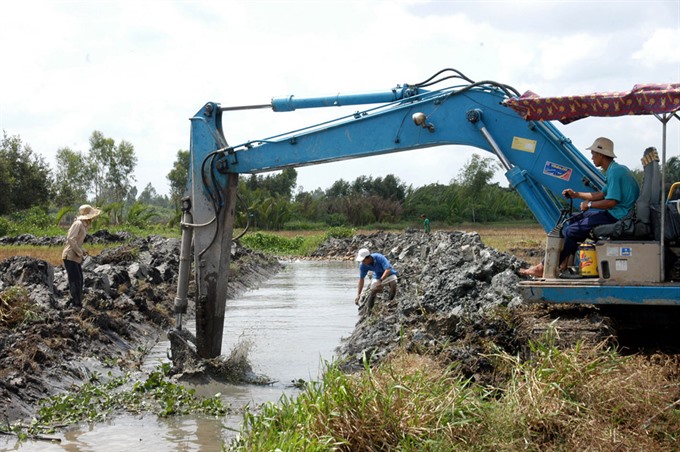 Society
Society

Many provinces in the Cửu Long (Mekong) Delta are taking measures to secure freshwater for farming and household use since drought and saltwater intrusion is expected to be severe in the 2016-17 dry season.
 |
| People use machines to work on a canal in Ngã Năm District, Mekong Delta province of Sóc Trăng to improve irrigation and prevent saltwater intrusion. — VNA/VNS Photo Hoàng Hải |
HCM CITY — Many provinces in the Cửu Long (Mekong) Delta are taking measures to secure freshwater for farming and household use since drought and saltwater intrusion is expected to be severe in the 2016-17 dry season.
Nguyễn Thiện Pháp, head of the Tiền Giang Province Irrigation Sub-department, said according to the Central Centre for Hydrometeorology Forecasting, the drought and saltwater encroachment into rivers would occur earlier than normal years.
Rivers are expected to have a salt content of 2 grammes per litre 55-60km inland in March and April next year, he said.
Saltwater has already flowed 20km up the Tiền River in Tiền Giang, according to the province’s Irrigation Sub-department.
Tiền Giang’s three eastern districts, Gò Công Tây, Gò Công Đông and Tân Phú Đông, which are often affected by drought and saltwater, have reduced the number of annual rice crops and switched to cash crops that require less water.
Nguyễn Văn Hải, head of the Tân Phú Đông Agriculture and Rural Development Bureau, said the district has dredged 17 canals to store freshwater.
The province has laid a pipe network that can carry 6,000cu.m of tap water daily from Gò Công Tây to Tân Phú Đông and provided local residents with water tanks to store freshwater, he said.
In addition, it has allocated VNĐ3 billion (US$136,000) to Tân Phú Đông to upgrade and lay new water pipes in residential areas that lack supply, he said.
The district will set up 33 public sites and six ponds where water will be provided to the public, he said.
“I think 45,000 residents here will be supplied water.”
Tiền Giang dredged on an emergency basis eight main canals in Gò Công Đông District with a total length of 30km to store water for the dry season.
It is also building four temporary dams in Cai Lậy District to prevent saltwater from entering the Tiền River.
Lê Văn Hoàng, director of the Long An Province Department of Agriculture and Rural Development, said his department has sought funds from the People’s Committee to dredge more than 10 irrigation facilities in Cần Giuộc, Cần Đước, Thủ Thừa and Tân Trụ districts and Tân An City.
Long An has also decided to build six dams along National Highway No. 62 to keep saltwater out of the Vàm Cỏ Tây River, which provides water for irrigation to Long An and Tiền Giang provinces.
In Bến Tre Province, saltwater had intruded 10km into the Bình Trung Canal in Bình Đại District by the end of October.
In Bến Tre, on November 26 Ba Tri District put into operation a plant that can desalinate 1,000cu.m of water with a salt content of 16 per cent daily.
It can meet the demand of 1,500 households for fresh water in An Hiệp Commune.
Huỳnh Thị Pha of An Hiệp said she hoped the lives of locals would improve with the plant since they can buy freshwater at regulated prices.
During the drought and saltwater intrusion last season, her family spent more than VNĐ2 million ($90) buying freshwater for drinking at high prices.
Authorities call for early rice crop
Authorities in the delta have urged farmers in areas susceptible to drought and saltwater intrusion to complete sowing the 2016-17 winter-spring rice early to avoid the impacts of the twin threats, which peak near the end of the crop.
Since the floods in the Mekong River have begun to recede, farmers in the delta are entering the main sowing period.
The delta, the country’s rice granary, is expected to plant 1.5 million hectares in the 2016-17 winter-spring rice crop, according to the Ministry of Agriculture and Rural Development’s plant cultivation department.
Based on the department’s schedule, farmers began sowing the crop last month and hope to finish by January 10.
This is the year’s main rice crop with its high yields and low costs compared to the others. Farmers here grow up to three crops annually.
Farmers in Đồng Tháp Mười (Plain of Reeds) in Đồng Tháp Province have this year sowed the crop two weeks to one month early to avoid drought and saltwater, according to the Department of Agriculture and Rural Development.
Cao Văn Hoá, deputy director of the Tiền Giang Province Department of Agriculture and Rural Development, said coastal districts had been instructed to grow only two rice crops this year and so did not grow the autumn-winter crop.
About 4,000ha had been left fallow during autumn-winter, and so farmers have been able to sow the winter-spring crop two months early, he said. — VNS